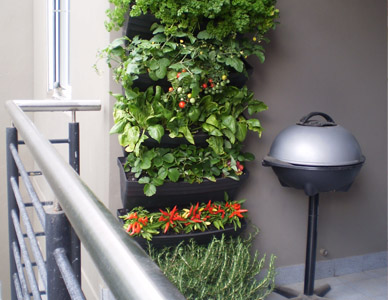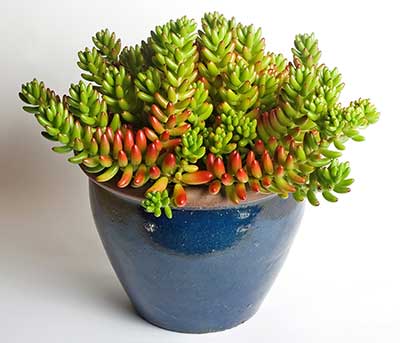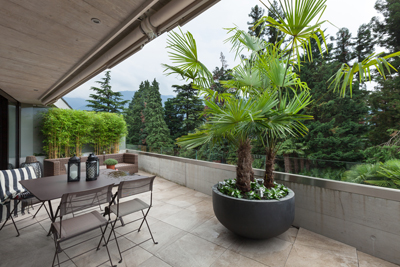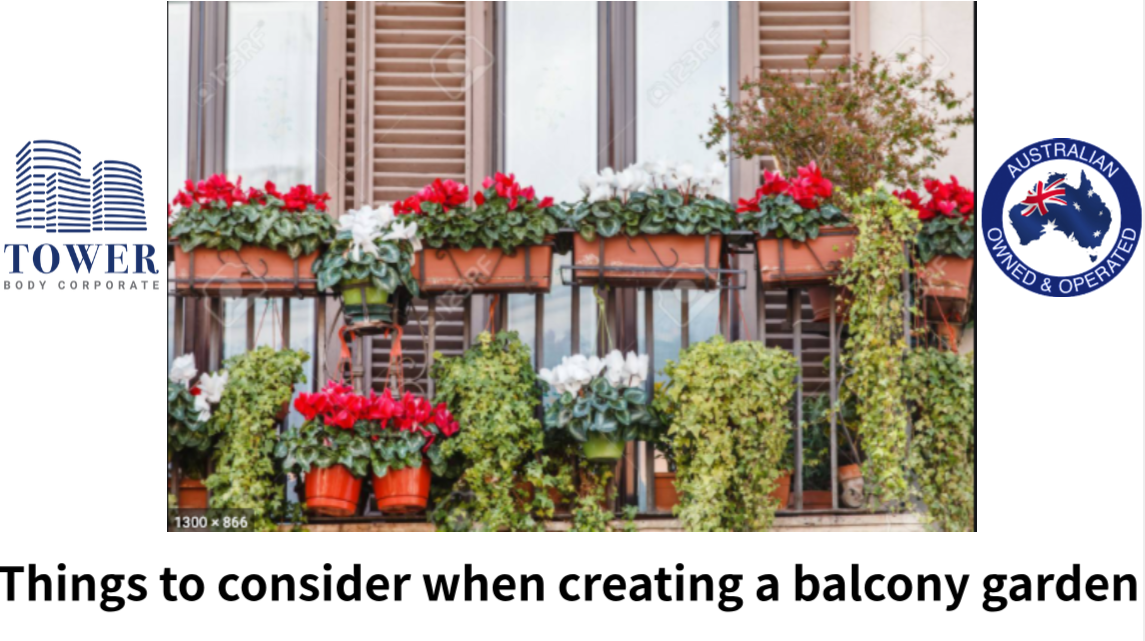With 1.3m Australians now living in an apartment (according to the 2016 Census), balconies have fast become the new Aussie backyard.
Greening your apartment and your balcony is a great way to bring nature into your home, and to create a soothing and healthy environment.
However, there are a few things to look into and to take care of so that you don’t upset anyone, or cause any property damage.
Are there restrictions on balcony gardens?
Firstly, you will need to speak to your Body Corporate to determine if there are any Scheme by-laws (rules) regarding plants on balconies.
- Must plants be under a certain height?
- Are there restrictions on types of plants?
- Can they hang over the edge?
- Are you allowed planter boxes – and if so are there colour and design restrictions?
- What about requirements for watering?
- Or, are they banned all together?
Body corporate law specialist Frank Higginson advises that by-laws are enforceable, but only to a point. It comes down to the individual rules and whether those rules are allowed to be made. In Qld and NSW if the rules are oppressive or unreasonable, the judicial body who regulates the disputes can say, ‘You know what, you can’t enforce that’.
Planning your balcony garden
Once you’ve established that you can have a garden on your balcony, it’s time to start planning it to ensure it will flourish, and not break any body corporate rules.
What you plant will depend entirely on the weather conditions. Your first step is observe how much light and wind your balcony receives during the day and what direction it comes from.
- East facing balconies – sunny first thing in the morning but shaded for the rest of the day.
- South facing balconies – tend to be shaded most of the time, but some are exposed to hot afternoon sun in mid-summer
If you have either of these orientations, select shade-tolerant plants and provide shelter from the hot sun by moving them away from the edge of the balcony or using a screen. Camellias and hydrangeas thrive in these conditions.
- North or north-easterly facing balconies – exposed to sunlight for the most part of the day. Perfect for growing flowering annuals, and many herbs and vegetables. The more sheltered from wind, the better the range you can grow.
- West facing balconies – tend to be sunny at the end of the day and can be scorchingly hot in summer. You’ll need to choose tough, heat and sun-tolerant succulents or dwarf bougainvillea. The area is likely to be very hot so plants will need additional water on hot days and during summer.
If your balcony is rather windy, your plant choices will be less, and you may need to install a wind break (if allowed), use heavy pots that won’t blow over, and choose plants that don’t have large leaves, because these will shred easily in the wind.
No matter what the orientation, if your balcony is shaded by a deep overhanging roof above, it’s best to treat it as shaded and select plants that prefer shade.
Designing your balcony layout
How you plant will depend on how much room you have, your budget, and your creativity. Balcony gardening can be as easy as adding one or two pots containing appropriate plants . . . through to using the services of a landscape designer to design and install flooring, seating, pots and vertical gardens.
Pot Selection
- Choose pots that won’t blow over, but are not too heavy for your balcony structure.
- Consider where the water will go. Are the pots self-watering, or will they need to sit on saucers so the water won’t destroy the balcony floor?
- Are they the right sized pots for the plants you choose? The rootballs of plants are usually the width of the plant, so choose pots big enough for the roots to grow, but not too big. Too big is known as ‘over-potting’ – and can cause a loose and unstable root ball.
- Terracotta pots and hanging baskets may need sealing or lining with black plastic to help prevent water loss. Ceramic and plastic, including self-watering pots, are good choices. Don’t use hanging baskets on a windy balcony.
- Consider a vertical garden too, if you’re allowed to. These are ideal for growing herbs in sunny spot, or lush ferns and “indoor” plants on a shady wall.
Keep it simple though, as a small space will seem smaller if there are too many plants, pots and different colours crammed together. Including a large pot filled with water lilies brings a new dimension of coolness and helps add humidity into the balcony microclimate.
Plant Selection
 Plants suitable for sunny balconies protected from the wind include:
Plants suitable for sunny balconies protected from the wind include:
- Bromeliads
- Dipladenia
- Herbs
- Petunias
- Vegetables – leafy and fruiting
 For really hot and dry balconies . . .
For really hot and dry balconies . . .
- Agave
- Bouganvillea
- Geraniums
- Jade tree
- Mother in laws tongue
- Rosemary
- Succulents and cacti
 For shady balconies, try these:
For shady balconies, try these:
- Ferns
- Fiddle leaf fig
- Golden cane palm
- Monstera deliciosa
- Parlour palm
- Peace lily
Plant Care
Growing plants in pots is a little different to growing in garden beds. Like children and pets, the plants will rely on you 100% for food, water and love.
Potting mix – always choose a good quality potting mix. Unfortunately cheap potting mixes are generally not worth it. You’ll need to mix in fertilisers, soil conditioners, minerals, water crystals and perlite to bring the mix up to the right standard that the potted plants will need to survive, so you may as well pay the extra and buy a high-quality mix right from the start. Also consider filling the bottom of the pots with polystyrene chips to keep the weight down.
Mulch – As pots can dry out quickly, it’s always worthwhile topping the soil with mulch to keep the roots cooler and the soil more moist.
Watering – succulents don’t need a lot of water, but most other plants will need watering at least once or twice a week in cooler months, and maybe daily on hot or windy days. Don’t let them sit in saucers of deep water either, as this can cause the roots to rot, as well as attract mosquitoes.
Feeding – When planting, ensure you mix a handful of controlled release plant food granules into the soil. There are different mixes available for different types of plants, or you can buy an all purpose one. It’s also a good idea to water with a soluble fertiliser a couple of times a year, as they do need nutrition to keep growing and flowering. Flowering and fruiting plants need a fertiliser high in potassium, whereas leafy plants need a fertiliser higher in nitrogen.
Trimming – Always trim off dead and diseased leaves, and remove spent flowers. It’s also a good idea to prune back straggly branches of shrubs to encourage bushier growth.
The joy of it all
Apart from having your own green haven, one of the best things about balcony gardens is that they are quite low maintenance. You just need to keep them looking trim and healthy, and maybe repot some as they grow.
Whether your goal is to grow you own food, create a private oasis or simply diffuse the starkness of your concrete balcony, a garden will bring calm into your surroundings and become a peaceful and healthy sanctuary to relax in..
Garden writer David Hobson came up with the best reason – “I grow plants for many reasons: to please my eye or to please my soul, to challenge the elements or to challenge my patience, for novelty or for nostalgia, but mostly for the joy in seeing them grow.”

